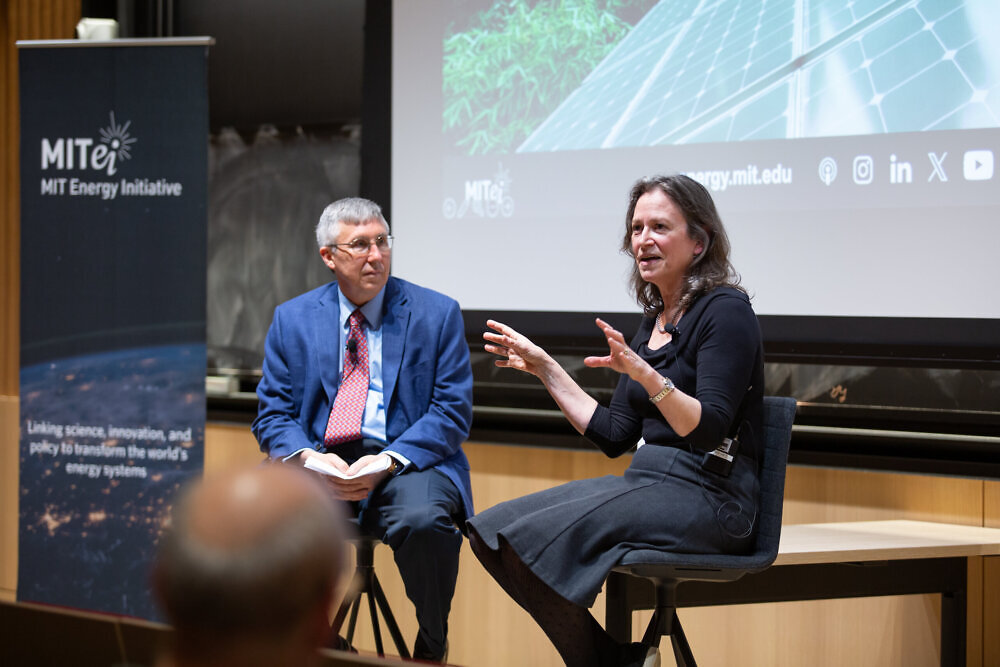
As the frequency and severity of extreme weather events grow, it may become increasingly necessary to employ a bolder approach to climate change, warned Emily A. Carter, the Gerhard R. Andlinger Professor in Energy and the Environment at Princeton University. Carter made her case for why the energy transition is no longer enough in the face of climate change while speaking at the MITEI Presents: Advancing the Energy Transition seminar.
“If all we do is take care of what we did in the past—but we don’t change what we do in the future—then we’re still going to be left with very serious problems,” she said. Our approach to climate change mitigation must comprise transformation, intervention, and adaption strategies, said Carter.
Transitioning to a decarbonized electricity system is one piece of the puzzle. Growing amounts of solar and wind energy—along with nuclear, hydropower, and geothermal—are slowly transforming the energy electricity landscape, but Carter noted that there are new technologies farther down the pipeline.
“Advanced geothermal may come on in the next couple of decades. Fusion will only really start to play a role later in the century, but could provide firm electricity such that we can start to decommission nuclear,” said Carter, who is also a senior strategic advisor and associate laboratory director at the Department of Energy’s Princeton Plasma Physics Laboratory.
Taking this a step further, Carter outlined how this carbon-free electricity should then be used to electrify everything we can. She highlighted the industrial sector as a critical area for transformation: “The energy transition is about transitioning off of fossil fuels. If you look at the manufacturing industries, they are driven by fossil fuels right now. They are driven by fossil fuel-driven thermal processes.” Carter noted that thermal energy is much less efficient than electricity and highlighted electricity-driven strategies that could replace heat in manufacturing, such as electrolysis, plasmas, light-emitting diodes (LEDs) for photocatalysis, and joule heating.
The transportation sector is also a key area for electrification, Carter said. While electric vehicles have become increasingly common in recent years, heavy-duty transportation is not as easily electrified. The solution? “Carbon-neutral fuels for heavy-duty aviation and shipping,” she said, emphasizing that these fuels will need to become part of the circular economy. “We know that when we burn those fuels, they’re going to produce CO2 [carbon dioxide] again. They need to come from a source of CO2 that is not fossil-based.”
The next step is intervention in the form of carbon dioxide removal, which then necessitates methods of storage and utilization, according to Carter. “There’s a lot of talk about building large numbers of pipelines to capture the CO2—from fossil fuel-driven power plants, cement plants, steel plants, all sorts of industrial places that emit CO2—and then piping it and storing it underground,” she explained. Offshore pipelines are much more expensive than those on land, but can mitigate public concerns over their safety. Europe is exclusively focusing their efforts offshore for this very reason, and the same could be true for the United States, Carter said.
Once carbon dioxide is captured, commercial utilization may provide economic leverage to accelerate sequestration, even if only a few gigatons are used per year, Carter noted. Through mineralization, CO2 can be converted into carbonates, which could be used in building materials such as concrete, and road-paving materials.
There is another form of intervention that Carter currently views as a last resort: solar geoengineering, sometimes known as solar radiation management (SRM). In 1991, Mount Pinatubo in the Philippines erupted and released sulfur dioxide into the stratosphere, which caused a temporary cooling of the Earth by ~0.5°C for over a year. SRM seeks to recreate that cooling effect by injecting particles into the atmosphere that reflect sunlight. According to Carter, there are three main strategies: stratospheric aerosol injection, cirrus cloud thinning (thinning clouds to let more infrared radiation emitted by the earth escape to space), and marine cloud brightening (brightening clouds with sea salt so they reflect more light).
“My view is I hope we don’t ever have to do it, but I sure think we should understand what would happen in case somebody else just decides to do it. It’s a global security issue,” said Carter. “In principle, it’s not so difficult technologically, so we’d like to really understand and to be able to predict what would happen if that happened.”
With any technology, stakeholder and community engagement is essential for deployment, Carter said. She emphasized the importance of both respectfully listening to concerns and thoroughly addressing them, stating, “Hopefully, there’s enough information given to assuage their fears. We have to gain the trust of people before any deployment can be considered.”
A crucial component of this trust starts with the responsibility of the scientific community to be transparent and critique each other’s work, Carter said. “Skepticism is good. You should have to prove your proof of principle.”
MITEI Presents: Advancing the Energy Transition is an MIT Energy Initiative speaker series highlighting energy experts and leaders at the forefront of the scientific, technological, and policy solutions needed to transform our energy systems. The series will continue in Fall 2025. For more information on this and additional events, visit: energy.mit.edu/events/